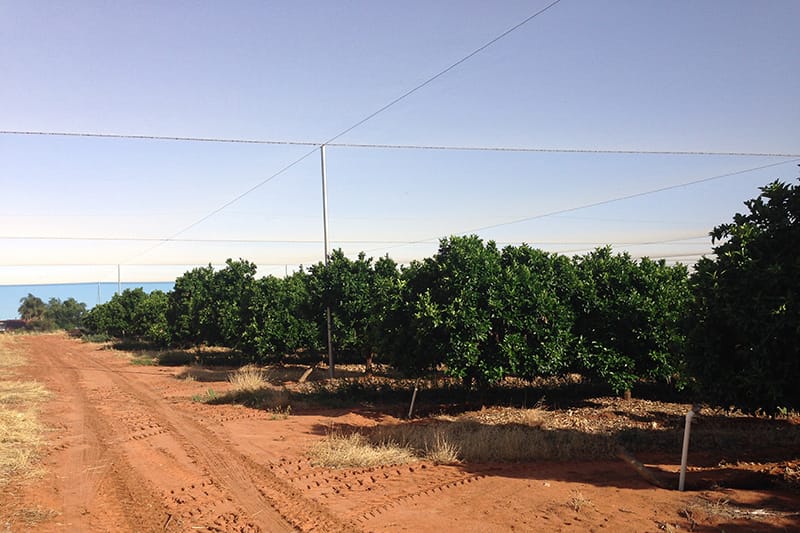05 March 2018
Netting more dollars for citrus growers
Netting more dollars for citrus growers
Netting improves fruit quality
Wind speed reduced under nets
Grower uses 10-15% less water under nets

Netted trial sites for citrus trees in South Australia’s Riverland are demonstrating numerous benefits for permanently netted tree crops extending well beyond traditional crop protection.
Continued observations and crop monitoring at two South Australian netted orchard trial sites at Loxton (apples) and Pyap (citrus) suggest there are numerous benefits to investing in permanent netting of tree crops. These benefits extend well beyond traditional crop protection benefits.
Building on the innovations employed through the Commonwealth Government’s On-Farm Irrigation Efficiency Program (OFIEP) delivered by the Natural Resources South Australia Murray-Darling Basin and Primary Industries and Regions SA (PIRSA) South Australian River Murray Sustainability (SARMS) Program, this study continues to investigate the potential benefits that permanent netting enclosures have on productivity.
To enable the scientific study of the trial site, instrumentation has been established at both properties with the participation of the University of Adelaide to enable the monitoring and comparison of a range of climatic and soil water indicators between netted and control sites.
Information and data being gathered include the effect netting has on mitigating hail damage, the incidence and effect of frost events, canopy structure and leaf area, fruitfulness, fruit quality and grade by variety. These monitored outcomes are being measured against crop water use, nutrient inputs and the efficacy of integrated pest management (IPM). As the project progresses, the summary findings are enabling the development of cost-benefit analyses that consider the worth of the system against the total cost of investment in the netting infrastructure.
Pyap produce co-owner Ryan Arnold said he had been very impressed with the outcomes of the netted trial.
“We have had some great improvements with overall fruit quality but particularly with navels, where there has been a big reduction in wind blemish and fruit appearance,” Ryan said. “Overall, I would say that netting has enabled us to get more consistent higher-class pack-outs and that is improving our fruit marketability.
“Additionally, we have found with varieties such as Afourer mandarins that we have been able to use the netting to reduce cross-variety pollination of the trees and this has improved our seedless outcomes.
“From a crop management perspective, we are finding that the efficacy of spraying is much better under the netting as well.
“I would say that overall we are using probably 10-15 per cent less irrigation water on the netted sites and getting instances where up to 30pc higher yield is achieved, with associated quality improvements. We are currently considering expanding our netted areas based on the results of the trial.”
Recent monitoring data compiled by the University of Adelaide shows clearly that solar radiation inputs are greatly reduced under netting (25pc less in some cases) and the flow-on effect of this is that evapo-transpiration is also reduced in the summer growing season. This reduction in early-season crop water stress is being linked back by both researchers and growers to better tree vigour at flowering and better fruit set.
In addition to this, monitored parameters such as soil temperature and wind speed were found to be much lower under the netting compared to the control, indicating the potential for increased chill in the winter period and protection from damaging wind gusts. Wind gusts of up to 125km per hour measured in March 2017 outside of the netting were found to be a mere 18km/hr under the netting. This example provided insight into why fruit quality was improved under netting.
ACKNOWLEDGEMENT
This project has been supported by the South Australian Murray-Darling Basin Natural Resources Management Board through funding from the NRM levies and SARMS. SARMS is funded by the Australian Government and delivered by the Government of South Australia through PIRSA.
The OFIEP is funded by the Australian Government and delivered across the southern connected system of the Murray-Darling Basin by the SA Murray-Darling Basin Natural Resources Management Board.
MORE INFORMATION
To find out more about the project (including future updates) contact Jeremy Nelson, project officer Natural Resources SAMDB, on 08 8580 1800 or jeremy.nelson@sa.gov.au
Membership
You are not logged in
If you are not already a member, please show your support and join Citrus Australia today. Collectively we can make big things happen.
